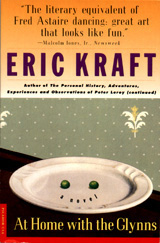
YOU CAN READ
|
Chapter 11
Salvage
|
|
|
AT HOME WITH
THE GLYNNS | CHAPTER 12 | CONTENTS
PAGE
|

| At Home with the Glynns |
by Eric
Kraft, as Peter
Leroy
|

YOU CAN READ
|
Chapter 11
Salvage
|
|
|
AT HOME WITH
THE GLYNNS | CHAPTER 12 | CONTENTS
PAGE
|
 Here
are a couple of swell ideas from Eric Kraft's vivacious publicist, Candi
Lee Manning: Here
are a couple of swell ideas from Eric Kraft's vivacious publicist, Candi
Lee Manning:
Tip the author. You can toss a little something Kraft's way through the Amazon.com Honor System or PayPal.
We'll send you notifications of site updates, new serials, and Eric Kraft's public lectures and readings. Just fill in this form and click the send-it button.
|
[MORE] DO YOU HAVE YOUR COPY? At Home with the Glynns is published in paperback by Picador, a division of St. Martin’s Press, at $11.00. You should be able to find At Home with the Glynnsat your local bookstore, but you can also order it by phone from: Bookbound at 1-800-959-7323You can order it on the Web from
Copyright © 1995 by Eric Kraft At Home with the Glynns is a work of fiction. The characters, incidents, dialogues, settings, and businesses portrayed in it are products of the author’s imagination and are not to be construed as real. Any resemblance to actual events or persons, living or dead, is entirely coincidental. All rights reserved. No part of this book may be reproduced or transmitted in any form or by any means, electronic or mechanical, including photocopying, recording, or by any information storage and retrieval system, without permission in writing from the publisher. First published by Crown Publishers, Inc., 201 East 50th Street, New York, New York 10022. Member of the Crown Publishing Group. The illustration at the top of the page is an adaptation of an illustration by Stewart Rouse that first appeared on the cover of the August 1931 issue of Modern Mechanics and Inventions. The boy at the controls of the aerocycle doesn’t particularly resemble Peter Leroy—except, perhaps, for the smile. |
ABOUT
THE PERSONAL HISTORY
LITTLE
FOLLIES
|